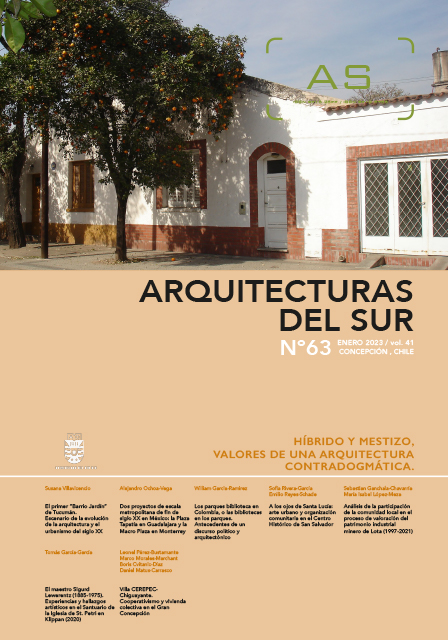In the eyes of Santa Lucia: urban art and communitarian organization in the Historic Center of San Salvador
DOI:
https://doi.org/10.22320/07196466.2023.41.063.04Keywords:
place attachment, urban art, citizen participation, urban renewalAbstract
Urban art has been and continues to be a transforming component within urban renewal processes, reinforcing memory, recovering the sense of place, and reducing stigmatization. This article delves into the role of urban art within the (physical-spatial) requalification and (symbolic) resignification processes in Urban Working-Class Settlements, analyzing how these processes are related to strengthening place attachment, sense of belonging, sense of security, and community organization, and trying to reflect on how they can affect deeper lying issues such as social and environmental risk. The methodology used is participatory action research, which was developed with the Santa Lucía Community in the Historic Center of San Salvador. Although the limitations of urban art are clear in the face of complex problems such as urban violence and environmental risk, the case of Santa Lucía reflects the potential of these interventions when they emerge as a collective and consensual expression, becoming an instrument of citizen vindication, strengthening community ties and organization.
Downloads
References
BOHIGAS, O. (1985). Reconstruir Barcelona. Barcelona: Ed 62.
BRANDÃO, P. (2011). La imagen de la ciudad: estrategias de identidad y comunicación. Barcelona: Publicacions i edicions de la Universitat de Barcelona.
BRANDÃO, P. (2014). Diseño urbano e interdisciplinariedad. On the W@terfront, (30), 58-72.
BRUGNOLI, P. (2011). Arte y ciudad: dispositivos de observación y representación. Revista 180, (27), 14-17.
CASTELLS, M. (1989). Social movements and the informational city. Hitotsubashi journal of social studies, 21(1), 197-206.
FERNÁNDEZ-LAVADO, C. (2010). Caracterización de la inundabilidad en el AMSS (El Salvador, CA). Programa IPGARAMSS.
FUNDASAL (2007). Caracterización de los asentamientos populares urbanos en El Salvador. Carta Urbana, (145), 1-16.
GARCÍA-DOMÉNECH, S. (2016). El espacio público como catalizador de la arquitectura, el arte y el diseño urbano. On the w@ terfront, (42) 7-24.
GIROLa, M. F., YACOVINO, M. P. y LABORDE, S. (2011). Recentrando la centralidad: procesos de recualificación urbana y espacio público en la ciudad de Buenos Aires desde una perspectiva etnográfica. Cuaderno urbano, 10(10), 25-40.
GUEVARA, P. y ARCE, R. (2016). Estado de la vivienda en Centroamérica. INCAE, Hábitat para la Humanidad. Recuperado de: http://www.rniu.buap.mx/infoRNIU/ene17/2/estado-vivienda-centroamerica_pguevara-rarce.pdf
HALL, T. y ROBERTSON, I. (2001). Public art and urban Regeneration: Advocacy, claims and critical debates. Landscape Research, 26(1), 5–26. DOI: https://doi.org/10.1080/01426390120024457
HIRSCH, S., BONELLI ZAPATA, A. L. y VALESE, F. (2021). “Estos murales dan vida”: revalorización del espacio público, la historia y la identidad en el arte mural, Festival Martín Fierro, San Martín, Argentina. Revista de antropología visual, (29), 1-27.
LACY, S. (1996). Mapping the terrain. New genre public art. Washington: Bay Press.
LEWICKA, M. (2011). Place attachment: How far have we come in the last 40 years? Journal of environmental psychology, 31(3), 207-230.
MANDEL, C. (2007). Muralismo mexicano: arte público/identidad/memoria colectiva. ESCENA. Revista de las artes, 61(2), 37-54.
MASSEY, D. (2012). Un sentido global de lugar. Barcelona: Icaria.
REMESAR, A. (1997). Hacia una teoría del arte público. Barcelona: Public Art Observatory.
REMESAR, A. (2019). Public Art Policies in Urban Regeneration Processes. On the W@terfront, 61(1), 3-65. DOI: https://doi.org/10.1344/waterfront2019.61.6.1
RICART, N. y REMESAR, A. (2013). Reflexiones sobre el espacio público thoughts on public space. On the w@terfront, (25), 5–36.
THEODORE, N., PECK, J. y BRENNER, N. (2009). Urbanismo neoliberal: la ciudad y el imperio de los mercados. Temas sociales, 66(10).
VÉLEZ, J. I., CABALLERO, H., ARANGO, A., SMITH, R. A., RAVE, C. C., ÁLVAREZ, A. D. y ESCOBAR, D. (2003). Definición de retiros en cuencas urbanas del Valle de Aburrá. Avances en Recursos Hidráulicos, (10), 7-16.
VIDAL, T. y POL, E. (2005). La apropiación del espacio: una propuesta teórica para comprender la vinculación entre las personas y los lugares. Anuario de Psicología, 36(3), p. 281-297.
Downloads
Published
How to Cite
Issue
Section
License
Copyright (c) 2023 Sofía Rivera-García, Emilio Reyes-Schade

This work is licensed under a Creative Commons Attribution-ShareAlike 4.0 International License.
The content of the articles published in each issue of Arquitecturas del Sur is the sole responsibility of the authors and does not necessarily represent the opinion of University of the Bío-Bío.
The authors will maintain their copyright; however, they will guarantee the journal the right to first publication and dissemination of their work. The publication of the article in Arquitecturas del Sur will be subject to the Creative Commons International license (CC BY-SA) that allows others to adapt: remix, transform and build on the material for any purpose, even commercially; share: copy and redistribute the material in any medium or format, as long as the authorship and first publication in this journal are acknowledged by citing them correctly, and their new contributions are under a license with the same terms.














 Programa de Información Científica/Concurso Fondos de Publicación de Revistas Científicas 2018/ Proyecto Mejoramiento de Visibilidad de Revistas UBB (Código:FP180007)
Programa de Información Científica/Concurso Fondos de Publicación de Revistas Científicas 2018/ Proyecto Mejoramiento de Visibilidad de Revistas UBB (Código:FP180007) 
